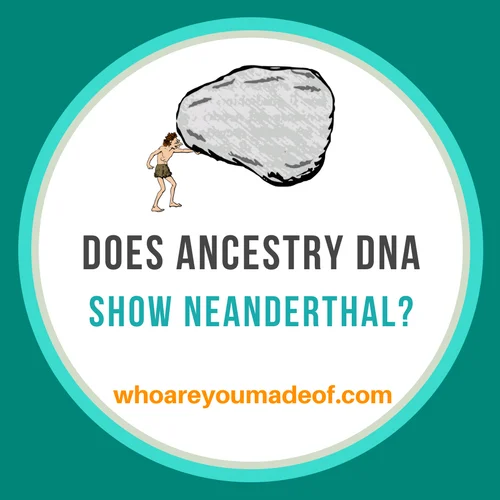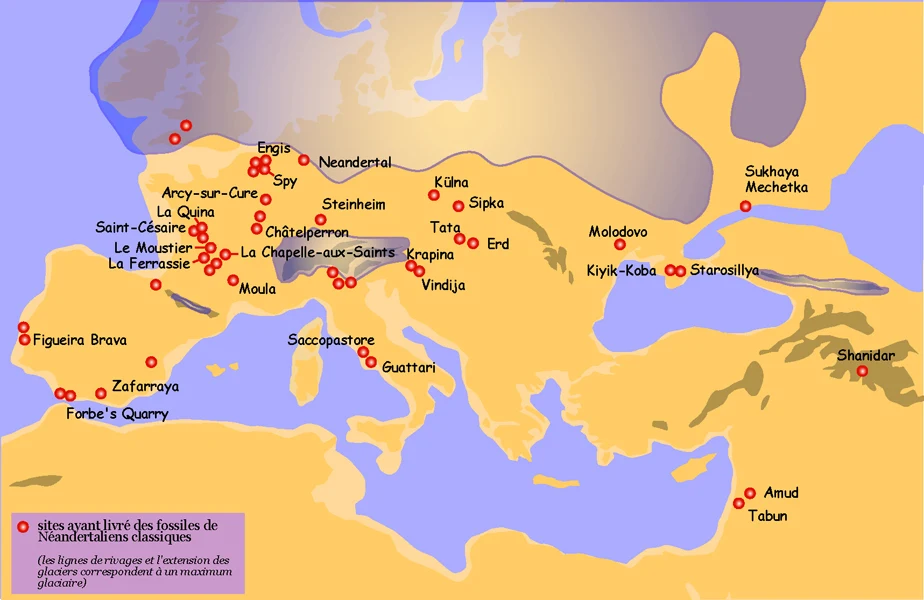Scientists say that everyone who lives outside of Africa in modern times has at least a tiny percentage of Neanderthal DNA. Have you ever wondered how much you have, if any? This article will explain whether Ancestry DNA will show your Neanderthal roots.
The Neanderthals lived in Europe and Asia, and when humans arrived out of Africa, their population declined. They are now extinct, and the explanation for their demise that is now becoming more accepted is that they "made love, not war" with modern humans.

Scientists believe that the last Neanderthal lived about 30,000-40,000 years ago.

The fact that the Neanderthals lived so long ago is key. There are a few different kinds of DNA tests that can give you insights into your ethnicity and ancestry.
Some tests are able to reach thousands of years back in time and tell you about your ancient roots. Other tests are more focused on the past few hundred years and are more useful for researching your family tree.
Does the Ancestry DNA test show Neanderthal?
The answer is no. The Ancestry DNA test is extremely helpful in understanding your family's recent ancestry (like the past 300-500 years). While some ethnicities can definitely show up a little further back than 500 years, the Ancestry test will not show you where your family might have come from 15,000 years ago.
The only major DNA testing company that currently offers a Neanderthal percentage in results is 23andMe.
Neanderthal results imply that you if you have a direct Neanderthal ancestor, even if the Neanderthal grandparent is like a 250th great-grandparent or something of the sort.
How can they tell this information? Researchers have sequenced the full genome of a few Neanderthal DNA samples that have been found over the past few decades.
They have determined a few hundred specific genetic markers that have been identified as Neanderthal in origin, and report to you how many you have, in essence.

What's the use of knowing if you are Neanderthal or not?
There is not currently much use in knowing whether or not you have Neanderthal ancestry. In fact, if you don't have substantial modern African roots, then you probably find Neanderthal in your DNA.
The main benefit in knowing whether you have Neanderthal DNA is primarily to have something cool to talk about at a cocktail party.
Science might continue to develop more insight into the significance of having Neanderthal ancestry, but for now, it's basically just proof that you can use to insult your brother when he makes you mad.
Ha!
Which DNA test should you do?
If you are interested in learning the most about your family's recent history - and I use "recent" as a relative term, especially compared to the times of the extinct Neanderthals - then you should do what is called an "autosomal DNA test".
This test is offered by several companies, but I would recommend the following three:
- Ancestry DNA (great for ethnicity, finding living family, family tree research)
- Family Tree DNA (ok for ethnicity, finding living family)
- 23 and Me (great for ethnicity and for finding family, some more expensive tests can also give health information)
As you can see, it really depends what your priority is. What is your goal by doing a DNA test?
If you want access to the largest US database of DNA tests in order to have the best chance of finding living relatives, then you should absolutely choose Ancestry DNA. It's my favorite test, and I can say with confidence that they really do have the best database for finding matches.
While the Ancestry DNA test does not provide you with your ethnicity results, you can download your raw data (you can do this with Family Tree DNA, too!) and upload it to a few different places to get more information.
As an added bonus, the software also compares your DNA to other ancient populations. That's how we like to roll in genetic genealogy.
If you want to go ahead and order an Ancestry DNA kit, I have special link for my readers. I do earn a small commission at absolutely no extra cost to you, and it helps me support this website: Get your Ancestry DNA kit and Discover the family story your DNA can tell.
Conclusion
I hope that this post helped you understand a bit about how Neanderthal likely ended up in your DNA, which DNA test is best for finding it, and alternative ways of finding out how much you have.
Did you find Neanderthal in your results? Do you have any questions or comments, or stories? I would love to hear from you in the comments.
Thanks for stopping by!


Mark
Tuesday 9th of May 2023
What's the relationship between the "Neanderthal DNA" and one's ethnicity DNA? Do these exist in different parts of one's DNA? Supposedly many of us have 2% Neanderthal DNA, and we share 99% of our DNA with chimps and bonobos. yet on ethnicity tests, one is said to have less than 1% DNA in common with 3rd cousins. so how do all these % relate to one another? Are these ethnic DNA numbers based on just a special section of our DNA that's separate from the 99%? How can we share 99% with other apes yet at the same time say that not all humans have this 2% Neanderthal DNA?
Peter
Thursday 28th of September 2023
@Mark, That's a really excellent question Mark - I'm just surprised how rarely it is asked! The simplest way to answer it is by pointing out that when geneticists say: "you share 98.7% of your DNA with chimpanzees", and then: "you can share as little as 2% of you DNA with a second cousin" ... they are really talking about DNA in very different ways. I like to use the analogy of puzzles. It isn't by any means a perfect analogy, but it is illustrative, and so can be helpful in getting your head around this apparent contradiction. Let's say that (nearly) all humans share the same basic puzzle type with the same (huge!) number of pieces, all forming the same large shape. So in that broadest sense, all humans share about 100% of their DNA in common. However WITHIN that shared structure of human DNA (our “puzzle” framework), the picture/pieces it displays will always differ: less so for very close relatives, and more so for distant relatives. Eg: Your personal puzzle will display a picture in which 50% of the picture pieces come from each parent. And yet, because DNA is random, you won't know which 50% come from which parent until you actually examine them all. So siblings, who share an AVERAGE of 50% of each other's picture pieces (DNA), may actually share as much as 61% - or as little as 37.5% in common. And similarly, second cousins may share as little as 2% or up to a maximum of about 6% of the picture pieces (or DNA) in common. But nethertheless, all humans (with the exception of those with Down Syndrome and a few other genetic mutations) still share the same puzzle FRAMEWORK: ie, the same basic shape of the puzzle, with the same basic arrangement and number of pieces. However, when we compare human DNA with other animals, such as chimpanzees, we are not comparing the pieces within the puzzles (as we do when comparing human relatives), but the actual "frameworks" of the puzzles themselves! And it turns out that the overall "puzzle" or DNA framework for chimpanzees is about 98.7% similar to humans in its basic shape, arrangement and number of pieces etc. But this is measuring DNA in a very different way to how we compare the DNA of our relatives WITHIN the human species! I hope this has been helpful.
Kristine Harder
Thursday 8th of April 2021
This is not true. My son's Ancestry.com test showed he had some percentage of Neanderthal.